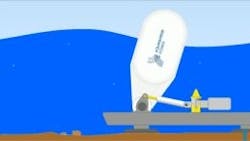Wave power harvested off Scotland
The world will know a lot more about how practical wavepower is as an energy source this year if a second-generation wave power device called Oyster 2 comes online as scheduled. The Oyster design is basically a buoyant hinged flap tethered to the ocean floor. It uses the force of the ocean’s waves to push the flap's two hydraulic pistons backwards and forwards, driving fresh water via an underground pipe to an onshore hydroelectric turbine.
The Oyster 1 wave power device was installed at the European Marine Energy Centre (EMEC) in Orkney, Scotland last summer and was hooked up to power lines in November. It is now undergoing sea trials
Data from Oyster 1 is helping Aquamarine finalize the design of the next-generation Oyster 2, which will be built this year to deploy next summer.
The new 800 kW device will measure 26 X 16 m and will deliver more than double the power of the Oyster 1. The new device incorporates design improvements on Oyster 1, enabling it to produce more energy, be simpler to install and easier to maintain.
Aquamarine Power, the wave energy company in Edinburgh, Scotland that built Oyster1, will begin deployment of three Oyster 2s at EMEC next summer. All three devices will be linked to a single onshore 2.4 MW hydro-electric turbine.
In 2013, Aquamarine expects to deploy multiple Oyster wave power devices in small clusters of typically 100 MW or more over a stretch of coastline off mainland Orkney. They hope to build a wave farm with an installed capacity of 200 MW.
The technology has been evolving since 2003 when it was first suggested by Professor Trevor Whittaker at Queen's University, Belfast. Aquamarine Power began commercializing the design in 2005.
The Aquamarine Power site contains several animations and videos that are helpful in understanding the Oyster's principles of operation: http://www.aquamarinepower.com/
